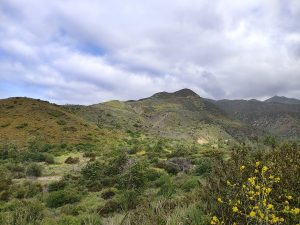The SMMNRA traverses 15 cities in Ventura and Los Angeles counties. The entire mountain range contains high avian species diversity among a range of vegetation types, including oak woodlands and grasslands. Resident and wintering bird species feed and breed in the Santa Monica Mountains, and many species also use the mountains during migration. There are federally-listed species, candidates for listing, and state species of special concern that have been documented. Because of the importance of the SMMNRA to protected species, as well as resident, wintering, and migrating birds in Ventura and Los Angeles counties, it is important to conduct long-term monitoring of their population trends to adequately manage their populations in the mountains. Monitoring data can provide information on locations and occurrences of bird species of special concern, as well as on trends in all breeding species’ densities, and will be critical for management as the impacts of climate change are felt, as well as the continuing impacts of urbanization, pollution, habitat loss, and impacts of non-native and feral species on bird populations.

Zuma Canyon in the Santa Monica Mountains
Starting in 2008, the WFVZ Bird Museum and Research Center began partnering with the SMMNRA to keep track of birds in the mountains. The initial project was on Grasshopper Sparrows (Ammodramus savannarum) breeding in the SMMNRA, for which Dr. Linnea Hall brought together a team of amateur and professional expert-level volunteer bird observers to determine the number of active breeding territories for the species. This one-year project helped form the basis of Dr. Linnea Hall’s subsequent efforts to determine the population size of shrikes on two Channel Islands (more information found here), and additional monitoring. In 2016, Dr. Linnea Hall collaborated with the SMMNRA staff to establish random point count stations throughout the Santa Monica Mountains and began conducting annual counts of breeding birds that year. In 2019, points were also established on adjacent Conejo Open Space Conservation Area (COSCA) land. People who have been extremely helpful to the WFVZ in getting these projects implemented are: NPS staff (Dr. K. Delany, M. Mendelsohn, J. Tiszler, and J. Algiers) and long-term volunteers (D. Kelly, R. Ammerding, T. Schmitt).
The current Community Citizen Science counting project relies on volunteers to conduct the bird monitoring and provides training in the methodology. It does require a two season commitment to the project. If you are already good at identifying birds by sight and sound (or want to get better at identifying them by sound), and are able to hike on canyon trails and roads, then this is the project for you! The NPS SMMNRA staff, and the COSCA staff, rely on these bird data for their management decisions in these important natural areas. Contact Dr. Hall (linnea@wfvz.org) for additional information!
For additional publications on field projects conducted by the WFVZ, please see:
